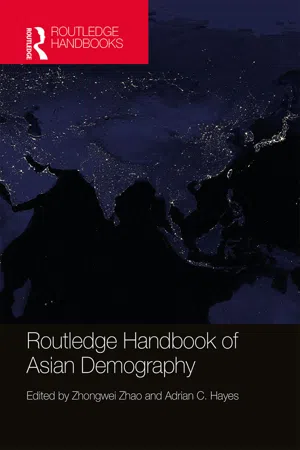
Routledge Handbook of Asian Demography
Zhongwei Zhao,Adrian C. Hayes
- 550 páginas
- English
- ePUB (apto para móviles)
- Disponible en iOS y Android
Routledge Handbook of Asian Demography
Zhongwei Zhao,Adrian C. Hayes
Información del libro
Home to close to 60 per cent of the world's population, Asia is the largest and by far the most populous continent. It is also extremely diverse, physically and culturally. Asian countries and regions have their own distinctive histories, cultural traditions, religious beliefs and political systems, and they have often pursued different routes to development. Asian populations also present a striking array of demographic characteristics and stages of demographic transition.
This handbook is the first to provide a comprehensive study of population change across the whole of Asia. Comprising 28 chapters by more than 40 international experts this handbook examines demographic transitions on the continent, their considerable variations, their causes and consequences, and their relationships with a wide range of social, economic, political and cultural processes. Major topics covered include: population studies and sources of demographic data; historical demography; family planning and fertility decline; sex preferences; mortality changes; causes of death; HIV/AIDS; population distribution and migration; urbanization; marriage and family; human capital and labour force; population ageing; demographic dividends; political demography; population and environment; and Asia's demographic future.
This handbook provides an authoritative and comprehensive reference for researchers, policymakers, academics, students and anyone who is interested in population change in Asia and the world.
Preguntas frecuentes
Información
| Region, country or territory | Surface area (000 km2) | Population (thousands) | Population multiplier, 1950–2015 | |||||
| 1950 | 2015 | |||||||
| Asia | 31,915 | 1,394,018 | 4,393,296 | 3.2 | ||||
| Eastern Asia | 666,586 | 1,612,287 | 2.4 | |||||
| China | 9,597 | 544,113 | 1,376,049 | 2.5 | ||||
| China, Hong Kong SAR | 1.1 | 1,974 | 7,288 | 3.7 | ||||
| China, Macao SAR | <0.1 | 196 | 588 | 3.0 | ||||
| China, Taiwan Province | 7,562 | 23,381 | 3.1 | |||||
| Japan | 378 | 82,199 | 126,573 | 1.5 | ||||
| Mongolia | 1,564 | 780 | 2,959 | 3.8 | ||||
| North Korea | 121 | 10,549 | 25,155 | 2.4 | ||||
| South Korea | 100 | 19,211 | 50,293 | 2.6 | ||||
| South-Eastern Asia | 164,900 | 633,490 | 3.8 | |||||
| Brunei | 5.8 | 48 | 423 | 8.8 | ||||
| Cambodia | 181 | 4,433 | 15,578 | 3.5 | ||||
| Indonesia | 1,911 | 69,543 | 257,564 | 3.7 | ||||
| Laos | 237 | 1,683 | 6,802 | 4.0 | ||||
| Malaysia | 330 | 6,110 | 30,331 | 5.0 | ||||
| Myanmar | 677 | 17,527 | 53,897 | 3.1 | ||||
| Philippines | 300 | 18,580 | 100,699 | 5.4 | ||||
| Singapore | 0.7 | 1,022 | 5,604 | 5.5 | ||||
| Thailand | 513 | 20,710 | 67,959 | 3.3 | ||||
| Timor-Leste | 15 | 433 | 1,185 | 2.7 | ||||
| Vietnam | 331 | 24,810 | 93,448 | 3.8 | ||||
| Southern Asia | 493,443 | 1,822,974 | 3.7 | |||||
| Afghanistan | 653 | 7,752 | 32,527 | 4.2 | ||||
| Bangladesh | 148 | 37,895 | 160,996 | 4.2 | ||||
| Bhutan | 38 | 177 | 775 | 4.4 | ||||
| India | 3,287 | 376,325 | 1,311,051 | 3.5 | ||||
| Iran | 1,629 | 17,119 | 79,109 | 4.6 | ||||
| Maldives | 0.3 | 74 | 364 | 4.9 | ||||
| Nepal | 147 | 8,483 | 28,514 | 3.4 | ||||
| Pakistan | 796 | 37,542 | 188,925 | 5.0 | ||||
| Sri Lanka | 66 | 8,076 | 20,715 | 2.6 | ||||
| Central Asia | 18,131 | 67,314 | 3.7 | |||||
| Kazakhstan | 2,725 | 6,703 | 17,625 | 2.6 | ||||
| Kyrgyzstan | 200 | 1,740 | 5,940 | 3.4 | ||||
| Tajikistan | 143 | 1,532 | 8,482 | ...|||||
Índice
- Cover
- Endorsement
- Half Title
- Series Information
- Title Page
- Copyright Page
- Contents
- List of figures
- List of maps
- List of tables
- List of Contributors
- Preface
- 1 Introduction
- 2 Asia’s major demographic data sources
- 3 The development of population research institutions in Asia
- 4 Asian historical demography
- 5 Fertility decline
- 6 Family planning policies and programmes
- 7 Family planning, contraceptive use and abortion
- 8 Reproductive health and maternal mortality
- 9 Son preference, sex ratios and ‘missing girls’ in Asia
- 10 Child mortality
- 11 Changes in old-age mortality since 1950
- 12 Age patterns and sex differentials in mortality
- 13 Trends in causes of death and burden of diseases
- 14 HIV/AIDS in Asia
- 15 Population distribution
- 16 The urbanization of low- and middle-income Asia
- 17 Asia’s international migration
- 18 Forced and refugee migration in Asia
- 19 Changing marriage patterns in Asia
- 20 Family and household composition in Asia
- 21 Asia’s demographic transition: Variations and major determinants
- 22 Human capital formation in Asia 1970–2010
- 23 The process of population ageing and its challenges
- 24 Demographic dividends
- 25 Population and environment in Asia
- 26 Population, the state and security in Asia
- 27 The demographic future of Asia
- 28 Conclusion
- Index